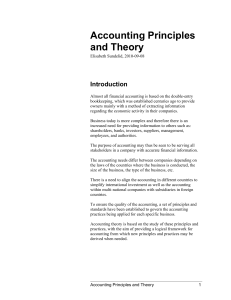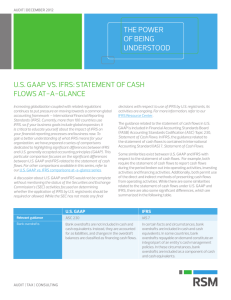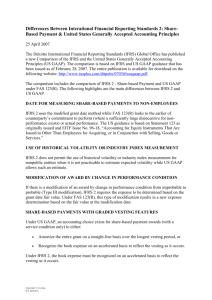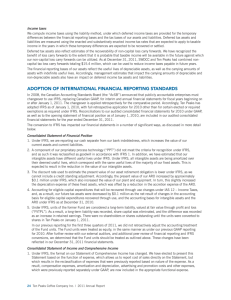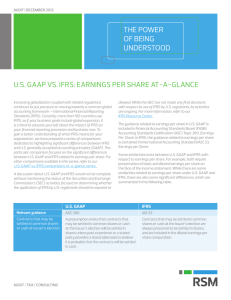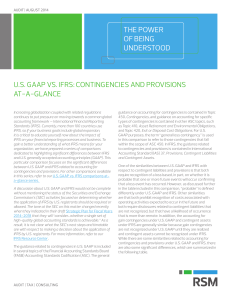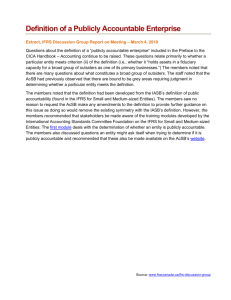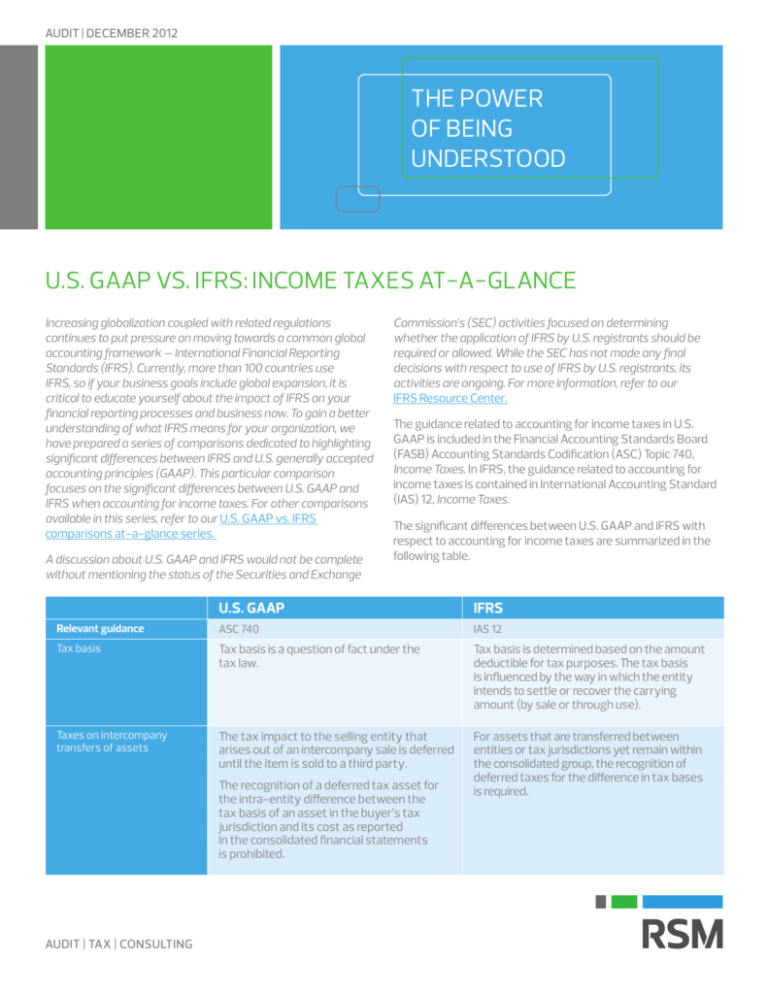
AUDIT | DECEMBER 2012
THE POWER
OF BEING
UNDERSTOOD
U.S. GAAP VS. IFRS: INCOME TAXES AT-A-GLANCE
Increasing globalization coupled with related regulations
continues to put pressure on moving towards a common global
accounting framework – International Financial Reporting
Standards (IFRS). Currently, more than 100 countries use
IFRS, so if your business goals include global expansion, it is
critical to educate yourself about the impact of IFRS on your
financial reporting processes and business now. To gain a better
understanding of what IFRS means for your organization, we
have prepared a series of comparisons dedicated to highlighting
significant differences between IFRS and U.S. generally accepted
accounting principles (GAAP). This particular comparison
focuses on the significant differences between U.S. GAAP and
IFRS when accounting for income taxes. For other comparisons
available in this series, refer to our U.S. GAAP vs. IFRS
comparisons at-a-glance series.
A discussion about U.S. GAAP and IFRS would not be complete
without mentioning the status of the Securities and Exchange
Commission’s (SEC) activities focused on determining
whether the application of IFRS by U.S. registrants should be
required or allowed. While the SEC has not made any final
decisions with respect to use of IFRS by U.S. registrants, its
activities are ongoing. For more information, refer to our
IFRS Resource Center.
The guidance related to accounting for income taxes in U.S.
GAAP is included in the Financial Accounting Standards Board
(FASB) Accounting Standards Codification (ASC) Topic 740,
Income Taxes. In IFRS, the guidance related to accounting for
income taxes is contained in International Accounting Standard
(IAS) 12, Income Taxes.
The significant differences between U.S. GAAP and IFRS with
respect to accounting for income taxes are summarized in the
following table.
U.S. GAAP
IFRS
Relevant guidance
ASC 740
IAS 12
Tax basis
Tax basis is a question of fact under the
tax law.
Tax basis is determined based on the amount
deductible for tax purposes. The tax basis
is influenced by the way in which the entity
intends to settle or recover the carrying
amount (by sale or through use).
Taxes on intercompany
transfers of assets
The tax impact to the selling entity that
arises out of an intercompany sale is deferred
until the item is sold to a third party.
For assets that are transferred between
entities or tax jurisdictions yet remain within
the consolidated group, the recognition of
deferred taxes for the difference in tax bases
is required.
The recognition of a deferred tax asset for
the intra-entity difference between the
tax basis of an asset in the buyer’s tax
jurisdiction and its cost as reported
in the consolidated financial statements
is prohibited.
AUDIT | TAX | CONSULTING
U.S. GAAP
IFRS
Use of valuation allowance
An entity records a full deferred tax asset
and then reduces that recorded asset by a
valuation allowance if realization of the asset
is not “more likely than not.”
An entity records a deferred tax asset if it is
probable (i.e., greater than 50 percent likely)
that the asset will be realized.
Changes in tax rates and laws
Changes in tax rates and tax laws used in
the calculation of income tax amounts are
reflected when enacted.
Changes in tax rates and tax laws used in the
calculation of income tax amounts are reflected
when enacted or substantively enacted. A rate
is considered “substantively enacted” when
only perfunctory actions are required for a
measure to become law.
Uncertain tax positions
A two-step process is applied. A benefit
is recognized when it is “more likely than
not” that the position will be upheld based
on its technical merits. The benefit would
be measured at the largest amount that
is greater than 50 percent likely of being
realized upon ultimate settlement.
Specific guidance pertaining to uncertain
tax positions is not provided. Tax assets and
liabilities should be measured at the amount
expected to be paid. If it is deemed more likely
than not that a liability has been incurred, the
entity would record the liability using either a
single-best-estimate measure or a weightedaverage probability of the outcomes.
Balance-sheet classification
The classification of deferred tax assets
and liabilities is related to the classification
of the asset or liability that generated the
temporary difference.
All deferred tax assets and liabilities are
classified as noncurrent regardless of what
asset or liability generated the difference.
Outside basis differences
An entity does not recognize a deferred tax
liability related to an investment in a foreign
subsidiary or corporate joint venture that
is essentially permanent in duration. This
guidance applies to all subsidiaries (foreign
or domestic), branches, associates and
interests in joint ventures.
An entity is required to recognize a deferred tax
liability unless: (a) the entity has control over
the reversal of the temporary difference and
(b) it is more likely than not (i.e., greater than
50 percent likely) that the temporary difference
will not reverse in the foreseeable future. The
exception applies solely to foreign subsidiaries
and foreign joint ventures that are essentially
permanent in duration.
These are the significant differences between U.S. GAAP and
IFRS with respect to accounting for income taxes. Refer to ASC
740 and IAS 12 for all of the specific requirements applicable
to accounting for income taxes. Refer to our U.S. GAAP vs.
IFRS comparisons at-a-glance series for more comparisons
highlighting other significant differences between U.S. GAAP
and IFRS.
Contact:
Richard Stuart, Partner
National Accounting Standards Group, RSM US LLP
+1 203 905 5027
richard.stuart@rsmus.com
+1 800 274 3978
www.rsmus.com
This document contains general information, may be based on authorities that are subject to change, and is not a substitute for professional advice or services. This document does not constitute audit, tax, consulting,
business, financial, investment, legal or other professional advice, and you should consult a qualified professional advisor before taking any action based on the information herein. RSM US LLP, its affiliates and related
entities are not responsible for any loss resulting from or relating to reliance on this document by any person. Internal Revenue Service rules require us to inform you that this communication may be deemed a solicitation
to provide tax services. This communication is being sent to individuals who have subscribed to receive it or who we believe would have an interest in the topics discussed. RSM US LLP is a limited liability partnership and
the U.S. member firm of RSM International, a global network of independent audit, tax and consulting firms. The member firms of RSM International collaborate to provide services to global clients, but are separate and
distinct legal entities that cannot obligate each other. Each member firm is responsible only for its own acts and omissions, and not those of any other party. Visit rsmus.com/aboutus for more information regarding
RSM US LLP and RSM International. RSM® and the RSM logo are registered trademarks of RSM International Association. The power of being understood® is a registered trademark of RSM US LLP.
© 2015 RSM US LLP. All Rights Reserved.
is_as_0915_ifrs_income_taxes_at_a_glance


